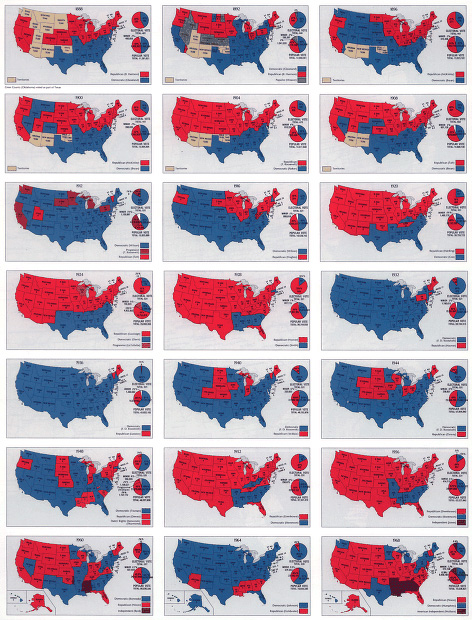Urban vs. Rural

“2004 U.S. Presidential Election Results by County,” Environmental Systems Research Institute for CBS News, November 2, 2004
See also “Red Counties, Blue Counties and Occupied Counties,” Kieran Healy, Department of Sociology, University of Arizona
The Margin

“Election 2004 Results,” Robert J. Vanderbei, Professor, Operations Research and Financial Engineering, Princeton University
Four Milestones

“Map of the Presidential Election of 1860,” U.S. Department of the Interior.
In 1860, Abraham Lincoln of the nascent Republican party sweeps the northern states to win the presidential election in a contest against the the Southern Democratic party. South Carolina secedes and the Civil War ensues.
In 1862, President Lincoln signs the “Emancipation Proclamation.” In 1865, the United States, led by President Lincoln, vanquishes the Confederate States of America.

“Map of the Presidential Election of 1904,” U.S. Department of the Interior.
In 1904, Republican Acting President Theodore Roosevelt wins 70% of the electoral vote with a progressive platform which comes to be known as the Square Deal. In deed and words, President Roosevelt works to lessen social and economic inequities, curb the power of corporations and conserve natural resources.
Roosevelt’s Secretary of War, William Howard Taft, wins another Republican victory in the presidential election of 1908. However, a schism between the progressive and conservative factions of the Republican party prompts Roosevelt to form the Progressive Party in 1912. Thus divided, Democrat Woodrow Wilson trounces the Republicans, winning win 82% of the electoral vote in 1912 as a progressive reformer with southern roots.
“I believe in a graduated income tax on big fortunes, and in another tax which is far more easily collected and far more effective—a graduated inheritance tax on big fortunes, properly safeguarded against evasion and increasing rapidly in amount with the size of the estate.” — Theodore Roosevelt, “The New Nationalism”

“Map of the Presidential Election of 1932,” U.S. Department of the Interior.
On October 24, 1929 the New York Stock Exchange collapses. On December 3, President Herbert Hoover, Republican, announces the economy is rebounding. By 1932, the U.S. banking system has collapsed and unemployment reaches 25 percent of the workforce.
On November 8, 1932, Franklin D. Roosevelt, the Democratic governor of New York, wins 88% of the electoral vote promising “relief, recovery and reform.” His New Deal creates the Securities and Exchange Commission, Social Security and welfare for dependent children and the handicapped.
Democrats will gain and maintain control of the U.S. Congress for all but four of the next five decades.

“Map of the Presidential Election of 1964,” U.S. Department of the Interior.
In 1948, the Democratic coalition of northern and southern states, forged by President Franklin D. Roosevelt during the Great Depression, is rent asunder by the party's embrace of an anti-segregationist platform. Led by South Carolina Senator Strom Thurmond, the disaffected southerners decamp to the newly formed States' Rights Democratic—or Dixiecrat—Party.
In 1956, Republicans win their second presidential election in 20 years with 57% of the popular vote and electoral college votes from Texas, Florida and Tennessee. In 1960, Democratic presidential candidate John Fitzgerald Kennedy picks Texas senator Lyndon B. Johnson to run against Republican Vice President Richard Nixon and Dixiecrat contenders Harry Flood Byrd, Sr. and Strom Thurmond. The Democratic ticket will win the popular vote with a .02 percent margin.
On July 2, 1964, Acting President Lyndon Johnson signs the “Civil rights Act 1964.” On August 7, 1964, the U.S. Senate approves the “Gulf of Tonkin Resolution,” marking the putative start of the Vietnam War.
During the presidential election of 1964, Arizona Senator Barry Goldwater wins the nomination of the Republican party. Goldwater, a co-founder of the Arizona chapter of the National Association for the Advancement of Colored People, challenges the traditionally northern Republican establishment by opposing the Civil Rights Act of 1964 on ideological grounds.
Senator Thurmond joins the Republican party and backs Goldwater for the presidency. Acting President Johnson receives 90.5% of the electoral vote and 61% of the popular vote.
This defeat is widely held to mark the beginning of the modern Conservative movement and the resurgence of the Republican party, particularly in the southern states. The GOP will retake the White House in 1968, 1972, 1980, 1984, 1992, 2000 and 2004. In 1994, Republicans will win control over the U.S. House of Representatives and Senate.
See also:
Nicholas Lemann, “The Controller”, The New Yorker, May 12, 2003
Mark Schmitt, “When Losers Win,“ The American Prospect, July 2, 2001

Based on CNN.com Election 2004.
“Mobilization
Plan,
Bush's Big Priority: Energize
Conservative Christian Base;
Unusual Strategy Plays Down
Importance of Swing Vote
As Demographics Shift.
A Coordinator in Each Church”
By JACKIE CALMES and JOHN HARWOOD,
Staff Reporters of THE WALL STREET JOURNAL
August 30, 2004; Page A1
Heating & Cooling Degree-Days

See also:
“The national atlas of the United States of America,” 1970.
Heartbeat


Click once to advance from 1888 to 1968. Click again to rewind.
Animation based on “Election Results, 1796 through 1968, The national atlas of the United States of America,” 1970.
Click here to display a synchronous view of this animation.

